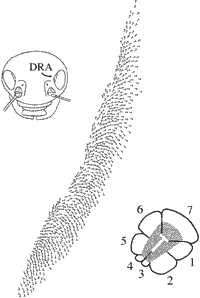
Insect Pol-neurons POL-neurons are visual neurons that respond to the e-vector orientation (oscillation plane) of plane-polarized light, i.e. their activity is a function of e-vector orientation. We have characterized extensively the physiology and morphology of some POL-neurons in crickets. The presence of POL-neurons could also be demonstrated in Cataglyphis ants but their physiology remains only incompletely described |
||
Sensory input to POL-neurons in the optic lobe POL-neurons in the peripheral visual system receive input from a group of specialized ommatidia situated at the dorsal rim of the compound eye termed "dorsal rim area" or "POL-area". The dorsal rim ommatidia are characterized by a number of properties that makes them especially suitable as sensors for polarized light. The photoreceptors are strongly polarization-sensitive and in many species have large acceptance angles. In addition, each ommatidium contains two populations of photoreceptors that are tuned to mutually orthogonal e-vector orientations, subserving polarization-opponency. Fig. 1 shows the fine structure and the arrangement of ommatidia in the POL-area of a cricket. The polarization-sensitive photoreceptors in the POL-area are homochromatic, i.e. UV-sensitive in honey bees, ants, flies and monarch butterflies, but blue-sensitive in locusts and crickets. |
|
more |
For more information see references: Blum, M. and Labhart, T. (2000) Photoreceptor visual fields, ommatidial array, and receptor axon projections in the polarization-sensitive dorsal rim area of the cricket compound eye. J. Comp. Physiol. A 186, 119-128 |
| Burghause F.M.H.R (1979) Die strukturelle Spezialisierung des dorsalen Augenteils der Grillen (Orthoptera,Grylloidea). Zool. Jb. Physiol. 83, 502-525 |
| Labhart T., Hodel, B. and Valenzuela, I. (1984). The physiology of the cricket's compound eye with particular reference to the anatomically specialized dorsal rim area. J. Comp. Physiol. A 155, 289-296. |
| Labhart T. and Meyer E P (1999). Detectors for polarized skylight in insects: a survey of ommatidial specializations in the dorsal rim area of the compound eye. Microsc. Res. Tech. 47, 368-379. |

